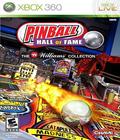Before world warriors fought things out in the street, before the earth was invaded by beings from space, before ghosts and dots alike feared a yellow circle with a voracious appetite, there was … pinball. Like the video game arcades of the past, pinball was huge back in the day. Every major hot spot, from diners to movie theater lobbies, had gaming machines installed, and people wanted to grab the highest possible score simply by hitting a metal sphere with a pair of plastic flippers. It grew popular enough that The Who made a song dedicated to the pastime. Sadly, like arcades themselves, pinball machines have become a scarcity, with only a precious few places still keeping these machines around. For those not fortunate enough to own a machine or live near a place that still sports them, the video game versions will have to suffice when you have a nostalgic craving for some pinball action. Luckily for modern gamers, Pinball Hall of Fame: The Williams Collection is an excellent video game translation of the machines of yesteryear.
The game acts as a compilation of some of the best pinball machines made by Williams from the late 1970s to the late 1990s. For those who paid attention to the pinball scene during those times, those years saw some pretty significant changes to the game. The games of the late '70s, like Gorgar, started to experiment with sound by adding synthesized voices as well as electromagnetic pits for special bonuses. Games of the '80s, like Taxi and Pin*Bot, were toying around with a few other innovations such as multiball, extra flippers and ball lock pits. Meanwhile, pinball titles in the '90s, like Medieval Madness and No Good Gofers, specialized in ball saving, animated LCD displays, and score matching for extra games.
The game has three separate modes that all revolve around the featured machines. Arcade mode gives you access to all of the tables featured in the game for single- or multiplayer play. Some tables already have free play unlocked, while others cost tokens to play. Tokens are earned by completing the basic and wizard goals available for each table, and those goals range from obtaining a certain score, making the multiplier go up to a certain number, or executing multiball a certain number of times. The tables that require payments can then have free play unlocked either through buying them with tokens or completing all of the goals on one table.
Williams Challenge mode brings you through a gauntlet of all 13 tables, tasking you with reaching the assigned high score before moving on to the next table. Tokens can also be earned here, and the user is given three continues before he or she is forced to quit the challenge and start over from the beginning. Tournament mode is good for up to four local players and has you play a selected table according to a complicated official pinball tournament scoring system. It's too bad that none of the modes feature true online play, but considering that pinball games were never designed with simultaneous play in mind, the online leaderboards for each table will suffice.
Based on what's included, you can easily tell that a lot of thought and care went into everything featured in the game. You'll get promotional fliers for all of the tables, but that is almost par for the course when it comes to old game compilations. The real treat comes in the instructions. They don't tell you how to play the game so much as what all of the pieces of the table do and what bonuses come from which combinations of objects being hit. It becomes your new cheat sheet for each table and shows you just how complicated a real pinball table can get.
There's plenty of praise to be heaped upon the game, but there are a few things that could be fixed. For starters, the menu system can become a bit of a chore to navigate through. Designed as a person walking through an arcade, you move left to right between machines before selecting the one you want to play. Not all of the machines are on the same area, though, so you'll constantly have to navigate between the first floor to the back room to the upper floor just to see everything and find the machine that you want. This wouldn't be so bad if there were a quicker way to go to the desired table, but since that isn't possible, you'll have to memorize where your favorite table is if you want to play it quickly. Also, while the credits system is a fine way to go and play the tables that you haven't unlocked for free play yet, the price for unlocking the tables is pretty steep. Considering that eight out of the 13 tables are locked for free play and one is just locked altogether, you'll either have to become really good at unlocking the basic goals presented in each table or just grind through each machine until you can buy your way to a new machine.
Controls don't get much simpler than a pinball machine, and Pinball Hall of Fame doesn't try to complicate things either. The left and right triggers control the left and right flippers, respectively. The ball plunger is activated by pulling back on the right thumbstick and releasing. While the choice may seem a bit odd at first, it actually is a perfect choice since good pinball players never try to pull the plunger at maximum force in order to achieve skill shots. Since every table except for Medieval Madness requires good plunger control, and the analog control is appreciated. The left stick controls tilt, and while the direction of the stick does determine where the tile is happening and with what amount of force, you'll barely want to touch it for fear of the table malfunctioning and invalidating the given round. Everything here is responsive, and no one can really complain at what the developers have done in this area of the game.
You can't ask for much from the graphics except for decent representations of the featured tables. What you get instead are near-perfect representations of the featured tables. Just about every bit of detail you remember from the old machines — such as the lights, bumpers and movable objects — are rendered perfectly, with every piece of text on the board being legible. Frame rate is smooth, as it moves at 60fps without any hint of slowdown. The LCD displays on the machines are also done well, even throwing in the flicker that some of the machines had, like No Good Gofers. The glass top of the machine is also reflective, which is a nice touch that can be turned off if you prefer. The only time the graphics become problematic is during the instructions phase. During the times that the instructions are telling you where bonuses are and how they get activated, it can become difficult to tell what's being talked about, thanks to a green arrow that's small enough to be hidden amidst the rest of the table background.
The sounds of the tables and the environment are spot-on. The sounds of bumpers being hit and flippers banging against the pinball are excellent, and since the tables are the focus of the audio in this arcade, you'll be able to really appreciate the sound effects sported by each machine and how they have evolved over time. The same goes for the music, as you'll notice it change from simple bass lines in the old machines to full epic scores in the later tables. You'll be surprised at just how powerful these tracks are if you're pumping them through a good speaker system.
The quality of sound doesn't stop with just the tables, though, as the rest of the arcade shows off its personality. While playing any table, you'll still hear the muted sound effects of the nearby faux video games. The music isn't anything you'll want to remember, but it fits the atmosphere nicely, especially the one song that sounds suspiciously like "Pinball Wizard" by The Who. As for voices, aside from the radio DJ, you have the narrator who reads through the instructions for each machine. Both do a good job at their respective roles, especially the narrator who gives off the right amount of enthusiasm for each table without overdoing it.
Xbox 360 gamers really only have two choices to get their pinball fix: Pinball Hall of Fame: The Williams Collection or Pinball FX. Luckily, both are great pinball titles in just about every aspect. Despite the price differences (this is $39.99, while the other is a downloadable title with various add-ons), the only real question to ask yourself is which type of pinball action do you crave the most? If you want your pinball to be an imaginary take on the late pinball scene, then Pinball FX is perfect. If you want an extensive history lesson on real pinball machines by one of the more respected manufacturers out there, then Pinball Hall of Fame: The Williams Collection needs to be in your collection. The only questions left to answer now would be when the sequel would be coming out and which manufacturer would be focused on this time around.
Score: 9.0/10
More articles about Pinball Hall of Fame: The Williams Collection











 Pinball Hall of Fame: The Williams Collection offers 13 Classic Williams tables from the '70s, '80s and '90s, including three new tables, as well as online leaderboards and trophies, multiplayer for up to four players and HD Compatibility.
Pinball Hall of Fame: The Williams Collection offers 13 Classic Williams tables from the '70s, '80s and '90s, including three new tables, as well as online leaderboards and trophies, multiplayer for up to four players and HD Compatibility.


































